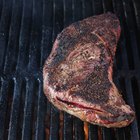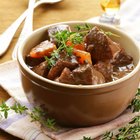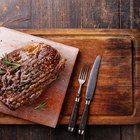
Cineberg/iStock/Getty Images
Cooking a beef sirloin tip roast involves a small amount of hands-on time that will deliver delicious results from your efforts. Because it is leaner than other cuts of beef, it is a healthier beef choice. However, the fat content will also affect how you prepare it. You will find a beef sirloin tip roast sold as a tri-tip, triangle steak or other regional name. The roast typically comes in weights from 1.5 to 3 lbs.
Trim off any excess fat on the roast. A thin layer is fine as it will baste the meat as it cooks. However, large areas of fat will contribute little to the flavor. Use a chef's knife or paring knife to trim as necessary.
Choose your seasonings. You can marinade a beef sirloin tip roast with a liquid marinade or with a dry rub. The marinade will flavor the outside of the meat while still allowing you to enjoy its natural beef flavor with the internal part of the roast. WhatsCookingAmerica.net recommends 1/2 cup of liquid marinade per pound of meat. With a dry rub, you need only coat the entire surface of the roast.
Preheat your oven to 450 degrees F to sear the outside of the roast. Searing will improve the appearance of the meat and increase its flavor. Alternatively, you can sear the roast in a skillet before placing it in the oven.
Place a rack in a roaster or deep baking sheet. Coat the rack with cooking spray to prevent sticking.
Use the cooking spray on the meat before seasoning to help them adhere to the meat. You can also brush olive oil over the entire roast. Season the beef sirloin with the desired seasonings. Herbs such as rosemary and thyme marry well with the beef.
Season the meat with salt and freshly ground black pepper. You can also use a blend of different types of peppercorns for more complex flavor. FoodandWine.com recommends salting lightly to help the the meat retain its juices.
Place the roast in the oven for 10 minutes. Then, lower the temperature to 250 degrees and cook until the meat reaches the desired degree of doneness. You can plan on about 10 to 20 minutes per pound. Check the temperature with an instant read thermometer. A medium-rare roast will be 125 to 130 degrees.
Cover the roast with aluminum foil as you prepare the gravy.
Place the roaster on the stove. Add 1/4 cup of brandy or red wine and scrape up the browned bits with a wooden spoon. Reduce the brandy until almost evaporated.
Add 1 cup of beef stock to the roaster. Allow it to reduce to 3/4 cup. Meanwhile, mix 1 tbsp. of cornstarch with 2 tbsp. of cold water. Add to the mixture and thicken.
Season the gravy to taste with salt and pepper. Off the heat, add 1 tbsp. of butter to give your gravy a luxurious finish. Slice your meat and serve.
Related Articles

The Best Ways to Cook a Buffalo Tri-Tip ...

How to Cook a Beef Roast in a Roaster ...

How to Roast an Eye Round Roast at High ...

How to Cook a 15-Pound Rib Roast

How to Cook a Beef Roast in a Roaster ...

How to Make a Blackbuck Antelope Roast

How to Cook Sliced Roast Beef for ...

How to Convection Roast a Brisket

How to Barbecue Roast Beef
How to Slow Cook a Pot Roast With Beef ...

How to Make a Black Pepper Crust on a ...

How to Cook a Beef Spleen

How to Slow Roast an Angus Roast

How to Use a Roaster Oven to Cook a ...

How to Cook Venison Shoulder Roast in a ...

How to Store Cooked Ground Beef

Calories in Beef Rump Roast
How to Cook a Spencer Roast
How to Smoke Venison Neck Roast

How to Cook Angus Beef in the Oven
References
- Whats Cooking America: Marinating Meat Guidelines - Marinating 101
- "Joy of Cooking: 75th Anniversary Edition - 2006"; I Rombauer, et al.; 2006
Tips
- Use low-sodium beef broth so your gravy will not be too salty. The fat in the roaster will contain some salt from the meat.
- Use only cold water with the cornstarch; otherwise it will not mix properly.
Writer Bio
Chris Dinesen Rogers has been online marketing for more than eight years. She has grown her own art business through SEO and social media and is a consultant specializing in SEO and website development. Her past work experience includes teaching pre-nursing students beginning biology, human anatomy and physiology. Rogers's more than 10 years in conservation makes her equally at home in the outdoors.
Photo Credits
Cineberg/iStock/Getty Images